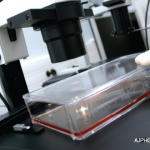 The immune system develops its complexity via a strictly coordinated nutrient metabolism and bioenergetics. Mature immune cells must be capable of two functions that require a great deal of bioenergetic support: entering the cell cycle upon stimulation by a mitogen and producing bactericidal factors. Although both actions demand heightened metabolic activity, they tend to occur at mutually exclusive times. During inflammation, immune cells must rapidly adjust their metabolic activity in response to environmental cues.
The immune system develops its complexity via a strictly coordinated nutrient metabolism and bioenergetics. Mature immune cells must be capable of two functions that require a great deal of bioenergetic support: entering the cell cycle upon stimulation by a mitogen and producing bactericidal factors. Although both actions demand heightened metabolic activity, they tend to occur at mutually exclusive times. During inflammation, immune cells must rapidly adjust their metabolic activity in response to environmental cues.
Macrophages, in particular, must maintain homeostatic proliferation in the presence of mitogens, such as colony stimulating factor-1 (CSF-1), while at the same time being able to engage in a rapid pro-inflammatory response to invading microorganisms. Such a cell fate change requires extensive reprogramming of the metabolism. This reprogramming can be seen when macrophages are treated with different stimuli. For example, macrophages treated with the mitogen CSF-1 respond with a time-dependent, up-regulation of glycolysis. The resulting rapid proliferation, as well as the heightened glycolysis, is similar to what is seen in tumor cells.
In contrast, when macrophages are given a pro-inflammatory stimulus, they rely on glucose catabolism, largely via aerobic glycolysis and the pentose phosphate pathway that runs parallel to glycolysis. Research suggests that the ability to make this metabolic switch is critical for the host-defense properties of macrophages. Further investigation into the switch has revealed two important transcription factors: the myelocytomatosis viral oncogene (Myc) up-regulates glucose and glucamine catabolism, and the transcription hypoxia-inducible factor alpha (HIF1α) regulates glycolysis. Interestingly, these transcription factors appear to play a role in metabolic switching in both immune cells and cancer cells. Additionally, research has indicated that Myc plays an important role in the CSF-1-induced mitogenic response in macrophages. However, up until now, further insights into the regulatory mechanisms behind the metabolic switch have remained elusive.
Lingling Liu, PhD, a research scientist at Ohio State University in Columbus, and colleagues published the results of their metabolic analysis online Feb. 9 in the Proceedings of the National Academy of Sciences.1 The investigators focused their research on macrophages and the distinct transcriptional programs that are engaged in response to mitogenic and pro-inflammatory stimulation.
The researchers asked whether up-regulation of Myc is required for CSF-1-driven rewiring in macrophages. To address this question, they deleted either Myc or HIF1α and found they were able to selectively impair the corresponding CSF-1- or lipopolysaccharide (LPS)-driven metabolic activities of bone marrow-derived macrophages (BMDM).
Closer examination of the pro-inflammatory response revealed that stimulation of macrophages with LPS plus interferon (IFN) ɣ resulted in an up-regulation of glycolysis, as well as the increased expression of glycolytic genes. Additionally, when the investigators inhibited glycolysis in vivo either via treatment with the pharmacological agent 2-deoxyglucose (2-DG) or via genetic deletion of HIF1α, they were able to suppress LPS-induced inflammation. Likewise, when they blocked glycolysis with 2-DG, they were able to protect mice against lethal endotoxemia. Thus, HIF1α—but not Myc—is required for the regulation of glycolysis in macrophages given pro-inflammatory stimulation.


